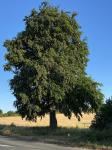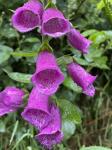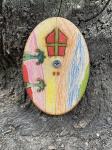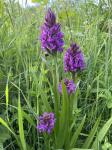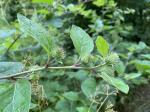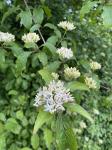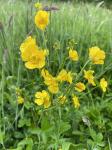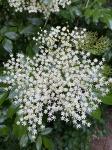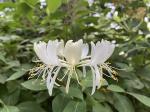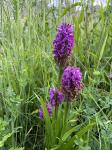Brayton Barff Through the Seasons.
Set in the Vale of York, South West of the market town of Selby and between the villages of Thorpe Willoughby and Brayton, lies Brayton Barff, a sandstone Hill approximately one hundred and fifty feet in height which was formed by glacial movement during the last Ice Age. It is a significant landmark in an otherwise flat landscape.
Today the site is primarily owned by Yorkshire Water with Selby District Council owning a small patch of the land adjacent to the A63 Selby bypass. A large underground reservoir occupies the centre of the site which delivers water to around 4.7 million customers throughout Yorkshire.
Within the Barff woodland over 40% of the trees are Sessile Oak which are generally found in semi natural woodlands in the north of the country. These trees are so called because its acorns are not held on stalks, like those of the English Oak (Pedunculate), but attached directly to the outer twigs. There are also several English Oak trees as well as some cross-hybrid oaks. These trees are known to support many species of flora and fauna, invertebrates, mosses, lichen and fungi.
During the Victorian times it is thought that the shipbuilders on the east coast would come over to the Barff for selected cuts of timber to build their sea going vessels.
The Barff also has a variety of other trees including Silver Birch, Beech, Sycamore, Holly, Rowan, Scots Pine, Alder, Hawthorne and European Larch. There are also several Yew, Willow, Hazel, Horse Chestnut and Wych Elm. As with similar woodlands there are a variety of bushes, including Honeysuckle, Elderberry, Gorse, Broom and Buddleia.
The history of Brayton Barff is quite vague, apparently during 1803 a beacon was lit on the Barff when the country was threatened with an invasion by Napoleon. In May 1935, to celebrate King George V's Silver Jubilee, a Bonfire was lit on the Barff as part of the celebrations.
Early issues of Ordnance Survey Maps dated 1903 clearly show a rifle range on the Barff, extending out to Mill Lane. During the 
Between 2001 – 2004 the A63 Selby bypass, 10km twin lane single carriageway was constructed which severed the South West corner of the Barff, adjacent to Selby Golf Course and resulted in a slight redesign of several holes on the golf course. Wooden fencing was erected as a result of this new road running alongside of the Barff and a footbridge constructed over the ‘new road’ following the line of the Bridal way which extends from Mill Lane. Around 2005/2006 a definite 2metre wide limestone aggregate footpath was laid forming a circular path around the outer edges of the woodland. This footpath is approximately 1.2 miles in length and takes about 30 minutes to circumnavigate at a leisurely pace.
In 2012 the Barff was declared an Ancient Oak Woodland and as such throughout 2012 and 2013 significant work had been carried out by the relevant agencies to cut and remove large swathes of non-native trees, creating at that time huge scars on the landscape. Some three years later the planting of the native trees have become well established and are flourishing. Ongoing maintenance work on the footpath around the bottom of the Barff was completed during the Summer of 2016.
A second phase of woodland maintenance commenced during the Autumn of 2019 with the removal of many old and diseased trees and the cutting back of the Gorse and Broom bushes, especially adjacent to the ‘bypass trail’, this work continued through till March 2020 with re planting continuing into April 2020.
Brayton Barff is a popular site for walkers and bird watchers alike and a path circling the outer perimeter of the Barff makes a pleasant thirty minute walk, giving views looking over towards Selby and the village of Brayton as well as the power stations of Drax and Eggborough..jpg)
For the early risers it is a great place to see some stunning sunrises over the villages of Brayton looking towards Drax Power Station, the same with the Sunsets looking over towards Eggborough and Monk Fryston.
The Barff changes with the Seasons and every visit can reveal something new, the woodland is a haven for wildlife. Records show that since 1982 one hundred and twelve species of bird have been seen in the woodland and at least 40 of those have bred here, including Tawny Owl, Buzzard, Green Woodpecker, Spotted Flycatcher, Goldcrest and Nuthatch to name just a few. On average over 70 species of bird are recorded each year. Further details of the bird life on the Barff can be found on the Brayton Barff Group Facebook page, especially the posts from Derek Cooper. Today ‘The Friends of Brayton Barff group’ led by Derek and a small team of volunteers help keep and maintain the cleanliness of the site as well as recording the wildlife and bird sightings.
The Barff is also home to fifteen different species of mammals, including Muntjac Deer, Pipistrelle Bat, Fox, and Field Vole.
Over eighty species of plant and wildflowers have been recorded, included Bee Orchid, Northern Marsh Orchid, Wood Anemone, Marsh Ragwort, Bluebell, White Bluebell, Bittersweet and Purple and White Foxgloves. Over twenty species of Butterfly have been recorded, including Marbled White, Brown Angus, Speckled Wood, Comma and Brimstone.
During the Autumnal months fungi thrives in this woodland environment, species including Fly Agaric, Beefsteak Tree Fungi, Chicken of the Wood, Sulphur Tufts, Stinkhorn, Ink cap, Puffballs and Hoof Bracket are just some of the many varieties that can be found here.
Click on the galleries shown below to expand the albums.
June 2022
What a lovely month on the Barff. Light mornings, dry, warm (over 10C at 6.00am) and sunny for the best part. All the greenery is growing apace, Brambles, Nettles, Grasses, Ferns and Foxgloves, some now well over 6ft in height at the moment, and still growing, Bramble briars are a bit of a pain, I am constantly either snagging my shirt/jacket or getting badly scratched legs and arms from their sharp briars, they seem to be shooting up at an alarming rate. On a positive Bramble note, looking at the blossom on them this year it looks as though it could be a bumper year for the fruit.
I enjoyed a very pleasant few days away to North Wales between the 13th to 18th June just for a change of scenery.
The weather during much of June on the Barff was mostly quiet, warm and uneventful, though we had a very warm spell in middle of the month whilst I was away which peaked at 30C on the 17th giving the woodland its warmest day of the year so far.
It was showery just once or twice, mainly just after the warm spell and again around the closing days of the month. At least all of the tracks have finally firmed up and dried out.
It was nice to see the Marsh Orchid again this year, I’ve only been able to find the one, but I know there are more, its just knowing where to look. As well as the Orchid there are lots of other wildflowers in flower this month, including Ragged Robin, several varieties of Buttercup including Creeping and Meadow, Cow Parsley, Dandelion, Birds Foot Trefoil and Broom. Foxgloves are in full flower, their purple-coloured bell-shaped florets providing a useful source of nectar for the bees. It was nice to see some pictures on social media this month of a Pyramidal Orchid found on the top of the Barff in an area that was heavily disturbed by Yorkshire Water contractors earlier this year.
I’ve noticed many of the apple trees along the far side of the ‘Bypass trail’ are bearing fruit, and along the same stretch of footpath the Buddleia bushes are in full flower and providing an ample food source for the Peacock and Red Admiral butterflies.
There are several varieties of fungi about at the moment too including Chicken of the Wood, Stinkhorn and Birch Polypore.
On a quiet still morning on the top of Tap hill, the scent from the Honeysuckle fills the morning air.
Work has continued throughout the month by ‘the friends of Brayton Barff’ to try and rid the Barff of the invasive flowering Himalayan Balsam and is ongoing.
I was pleased to see the contractors cutting back the overgrown nettles, brambles, ferns and grasses on both sides of the perimeter footpath albeit about 18 inches both sides, it is still quite dense though. The Bridal footpath which forms part of the ‘Selby Horseshoe’ and runs parallel with the bypass is now very heavily overgrown, how the horse riders manage to get through the long grass, briars and weeds I don’t know as much of it has grown to over 6ft in height. I remember the time when you could walk 6 abreast along this bridal way, now it is difficult with just one abreast.
All our usual birds can be seen and heard, Robin, Chaffinch, Blue and Great Tits, Long Tailed Tits all follow me on my morning walks through the woodland, as do the Wood Pigeons.
The Greater Spotted Woodpeckers are still feeding their young though by the end of the month the majority of them look to have fledged.
There are lots of Blackcaps singing around the Barff as are the dulcet tones of the Chiffchaff.
I keep receiving sightings of the Tawny owls and their offspring’s from around the woodland, I think the youngsters will be fledging shortly, there is still an ample food source for them in the form of Bank voles and Moles especially if the weather stays fine and dry.
I watched and heard a lone Oystercatcher fly over on the morning of the 27th, its bright orange beak glistening in the bright morning sunlight, as well as its piercing call cutting through the morning air.
I often watch the Tree Creepers as they climb and run up and down the tree trunks in their search for bugs and creepy crawlies, their slight curved beaks ideal for levering their food out from the crevices in the bark.
Sadly, as the moth draws to a close the Marsh Orchids look to have passed their best for another year and died right back. I still haven’t found any Bee Orchids, nor have I heard the Cuckoo. That aside, June has been an excellent month for wildflowers on the Barff and every day you can find something new.
|









